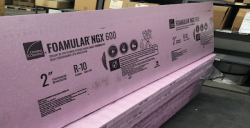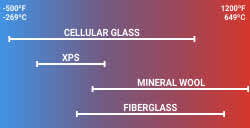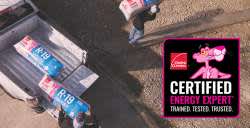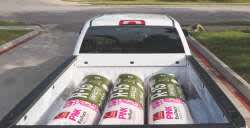
Making home a better place to be: Roof to Basement
Whether it's a winter coat or your home, insulation plays a key role in temperature regulation. Think about wearing a light rain jacket in 20-degree weather versus a heavy down parka.
Your home is an important place for you and your loved ones. Making sure your home is a safe, comfortable, and better place to be starts with the materials used to protect your home from the elements, roof to your basement.
Home/Residential Insulation
One key material for keeping your home comfortable is insulation. Insulation plays a critical role in temperature regulation.
Imagine a winter’s day with temperatures below freezing – would you rather be outside wearing a light rain jacket or a heavy down parka? A rain jacket may help to keep you dry, but without an insulating layer, the cold “goes right through it” and you would soon be reaching for the heavy down parka. The down feathers in the parka act as an insulating layer between you and the cold air, allowing you to maintain warmth and withstand the outdoors to a certain degree.
The insulation in your attic, walls, basement, and floors provides the same kind of benefit, creating a more comfortable living environment. Other benefits of a properly/sufficiently insulated home include increasing your home's energy efficiency and reducing the risk of ice dams forming on the roof.
But, when it comes to insulation, a lot of questions may arise. For example, what kind of insulation should you buy? Do you need to insulate interior walls?
Why is insulation pink?
You can find the answers to these and many other questions in this beginner's guide to insulation — roof to basement. Plus, get pro tips on insulation techniques from the experts at Owens Corning.
Types of Insulation
If you visit any home improvement store or browse their products online, you may be surprised at the varieties of insulation available. The shapes and materials are designed to work in a particular way and for specific applications, from fiberglass batts to rigid foam boards.
So how do you know which insulation is best for your purpose? Online retailers typically list which applications the products are best suited for and provide a complete listing of product specifications from the manufacturer. By reading and comparing, you should be able to narrow your choice down to one or two items that will meet your needs. Choosing a well-known brand that stands behind its products is a smart move, as well.
Let's take a look at some of the most popular types of insulation for residential use.
Fiberglass Insulation
Most homeowners are familiar with fiberglass insulation. Made from spun fibers of molten glass and formed into batts or rolls, fiberglass insulation can be used throughout the home. Not only is fiberglass multipurpose, but it offers homeowners many benefits:
- Favored by contractors and DIYers for its ease of installation
- Available in a variety of thicknesses and R-values
- Provides acoustic benefits
- Cost-efficient
- Suitable for walls, ceilings, attics, floors and basements
- Owens Corning PINK Next Gen™ Fiberglas™is soft to the touch and produces less dust when cut or split
Fiberglass comes with facing or without. Facing is attached to one side of the insulation and is typically made from either Kraft paper or foil. Facing is a vapor retarder, helping to control the movement of water vapor.
Pro tip: Kraft paper should not be exposed and must be covered by and in contact with a thermal barrier like gypsum drywall.
Loosefill Fiberglas
An effective way to install attic insulation is by using loosefill fiberglass. A blower machine helps propel the insulation into spaces that are often left bare, like the edges of the attic under the eaves. Using loosefill fiberglass insulation in this way can not only make your home more energy-efficient but can help prevent ice dams and their resulting moisture problems. You can also use loosefill in closed cavity work, such as interior walls.
Specialty machines, like the Owens Corning AttiCat®, make it possible for the home DIYer to insulate the attic themselves. Many home improvement stores will rent a machine or offer one free for 24-hour use with a minimum purchase of loosefill insulation bags.

Pro tip: During attic installs, use baffles at the soffits to ensure that the insulation does not block ventilation.
Of course, choosing to work with a trained professional takes the burden off your shoulders and helps you get the most advanced insulation solutions. Owens Corning's Certified Energy Expert® Professionals have hands-on experience with all types of insulation, including loosefill fiberglass and have been tested on their installation techniques. These elite professionals can offer you a lifetime limited warranty on workmanship in addition to Owens Corning's premium product warranty.
It's easy to find an independent insulation consultant near you with the Owens Corning ZIP Code search tool. You'll find links to individual websites and details on any special certifications the consultant may have earned.
Extruded Polystyrene (XPS)
XPS foam board is made by mixing melted raw materials and forcing, or extruding, the mixture through a custom die to form a homogenous rigid board. This process helps make XPS boards extremely durable and moisture resistant.
Owens Corning® FOAMULAR® XPS is a high-performing insulation suited to various building uses, including above- and below-grade residential and commercial applications. The company's proprietary HYDROVAC manufacturing process ensures a consistent closed-cell structure that is free of voids, keeping moisture out while delivering an R-value of 5 per inch of thickness. In fact, tests show that FOAMULAR® insulation can maintain its R-value even when exposed to standing water and wet soil.
FOAMULAR® offers homeowners and contractors many benefits:
- Available in compressive strengths from 15 to 100 psi
- Easy to handle across job sites and climate zones
- Reliable insulation solution for roofs, foundations and walls
Mineral Wool
Mineral wool is another insulating material suited to commercial and residential applications. Mineral wool batts are slightly stiffer than fiberglass. The product is made from molten industrial slag, and Owens Corning's Thermafiber® is manufactured from a minimum of 70% recycled content. In addition to having excellent insulating properties, mineral wool is water, fire, and mold resistant. The material is highly regarded for its acoustic benefits.
You can also find mineral wool in loosefill form for attic applications.
R-Value
When you're shopping for insulation, whether online or in person, you'll often see information regarding the R-value of the product. You may wonder what R-value is and how it relates to your insulation choice. R-value ratings are assigned based on a material's resistance to the thermal transfer of heat. As the R-value increases, so does the insulation's ability to resist heat flow.
For instance, insulation with an R-value of 13 will allow much more heat or thermal energy to flow through it than insulation with a rating of 21.
What affects R-Value?
Many factors help determine a product's R-value, and the rating varies based on the product, its density, and its thickness. For example, a 3.5-inch-thick piece of insulation may have an R-value of 13 or 15, depending on its density, while a 12-inch-thick batt of insulation may have a rating of R-38 due to the increased thickness.
Pro Tip: R-values are located on the outside of the package in bold print. Look for the R-value that fits the framing you are insulating.
How Do You Know Which R-Value of Insulation to Use?
Fortunately, there are a lot of resources around to help you determine the correct R-value for your region of the country. Energy.gov offers several maps and zone charts to ensure you have the right amount (or thickness) of insulation with the proper R-value rating. Additionally, local building codes usually have minimum R-value ratings and insulation standards as well.
Insulation contractors, like Owens Corning Certified Energy Expert Professionals, can also help you choose the best R-value for your home. They work with individual homeowners as well as builders, offering top-quality materials, expert advice and are practiced in the latest installation techniques.
DIY Insulation Tips: What You Need to Know About Insulating Your Home, Roof to Basement
The Department of Energy promotes the use of insulation throughout every area of the home. While this fact is important for anyone building a new home, it's just as critical for people in older residences. Adding insulation to an existing home can help make your home more energy-efficient, reducing heating and cooling costs. The really good news is insulation is an ongoing investment. The savings repeats itself year after year.
Attic Insulation
Adequate attic insulation is critical to roof system performance and improving the energy efficiency of your home. By limiting heat transfer into your attic spaces, you can help protect your home from ice dam formation and the moisture intrusion that can follow.
Adding attic insulation is one of the simplest ways to reduce your heating bill, and the savings just keeps adding up. It's easy to measure how much insulation you currently have with a tape measure. Then take a look at the Department of Energy's recommendations per climate zone to see your R-value target.
Follow some of these tips for improved attic insulation.
- First, make sure your roof deck is in good condition, without any signs of water infiltration.
- Seal all ceiling air leaks. You can use caulk or canned gun foam.
- Place fiberglass insulation between joists and make sure it completely covers them.
- Use baffles at the soffits to keep the ventilation path open.
Pro Tip: It is easier and more effective to install loosefill fiberglass in the attic for a roof pitch of 5:12 or below. If you’d rather work with a professional, find an independent roofing contractor in the Owens Corning Roofing Contractor Network (OCCN) who is “Top of the House” certified.
Wall Insulation
We all know that exterior walls must be insulated. But did you know that insulating interior walls can improve the comfort of the homeowner by reducing the amount of sound traveling from room to room?
You’ll find plenty of options when choosing insulation for exterior walls. Batts are available in different R-values to fit 2x4 and 2x6 framed walls. Another solution is to use continuous insulation, like FOAMULAR™, over the exterior sheathing. Using continuous insulation reduces the thermal breaks that can occur in framing applications, making the exterior wall more energy efficient and providing better homeowner comfort. An insulation contractor can also fill exterior cavities with loosefill.
- Batts are sized to fit the length of wall cavities eliminating the need for measuring and cutting.
- Rolls are great for attics or floors and can easily be cut to size. A simple utility knife is all you need to trim and cut pieces.
- Batts and rolls are designed to friction fit in place. Just position in the frame, making sure the insulation completely fills the cavity, and avoid compressing it. If using Kraft facing, you can add staples if needed to hold the insulation in place.
Pro tip: Fiberglass insulation is easy to split to go around wires or plumbing and easy to cut to fit around electrical boxes or other obstructions.
Loosefill insulation can also be added to existing walls by creating an opening, filling the space with insulation and then resealing.
Floor Insulation
Regardless of whether you have carpet, hardwood or tile, floor insulation can help prevent thermal heat transfer and keep your rooms more comfortable. Floors built over an unheated space or on top of a slab are part of the thermal envelope and should be insulated.
Your home's thermal envelope helps protect the interior of your home from outside influences. To visualize this better, think of placing your home inside a document sleeve or binder. The protective sleeve keeps out unwanted moisture and unconditioned air. Any opening in the thermal envelope creates the potential for energy loss.
Insulating your floor:
- Helps regulate inside temperatures
- Protects pipes in the flooring from extreme cold
- Absorbs sound traveling from one level of the home to another
Fiberglass batts can friction fit between floor joists, then either rest the insulation on a ceiling or hold it in place with wire ties.
Pro tip: Before beginning any floor insulation project, have a professional check for moisture problems. You may need unique products or specialized techniques if you're attempting to insulate a damp basement and/or concrete slap floor.
Air Distribution
Ducts in walls, unconditioned spaces like attics and crawlspaces, and some basements should be air sealed and insulated. Sealed and insulated ducts deliver warm or cold air to the register with minimal heat loss. Duct insulation, thanks to its FRK vapor retarder, can also reduce the opportunity for condensation on the duct when delivering cold air through a hot attic.
Air Sealing
As mentioned earlier, even the smallest of openings is an opportunity for heat/cold loss. It's a good idea to walk through your home from top to bottom, looking for possible air leaks. You might be surprised at how many you'll find. Weatherstripping, caulking and canned gun foam are some of the many items used to draft-proof a home.
Use canned gun foam in areas where you have tiny cracks or openings, such as in the band/rim joist and penetrations in foundation walls or the ceiling.
Basement Insulation
Whether a basement, crawlspace or concrete slab, the foundation of your home is another crucial spot that needs to be adequately insulated. Not only can insulation help lower those pesky heating bills, but it helps guard against moisture in the basement and insect problems.
During the initial home build, it's relatively easy to apply XPS foam board to the exterior of basement walls. However, that's not practical for present homes. One option to insulate existing basement walls is to use Foamular XPS with a compatible adhesive or one-part spray polyurethan canned foam. A protective or thermal barrier is required to separate this product from interior living or conditioned spaces as specified in the appropriate building code. Another option is to frame out walls, then insulate and finish them. As always, you should follow local building codes regarding vapor retarder needs or requirements.
You'll need to consider a few additional factors if you're looking to insulate slab or crawlspace areas. In a crawlspace, the type and method of insulation will depend on whether the area is ventilated or unvented. Slab foundations must follow local building codes and insurance guidelines and take into account the prevalence of termites in the region.
DIY Insulation
If you decide to do your own home insulation, here are a few tips to keep in mind.
Insulation Safety
During any home improvement project, safety should be your first priority. Using a name-brand, quality insulation product that's formaldehyde-free like Owens Corning PINK Next Gen™ Fiberglas™ is a great start. Other safety tips include:
- Keep covered. It’s best to install insulation in long sleeves and pants. Gloves and eye protection are also recommended.
- Clean up. After the project is complete, store any leftover insulation in a dry area and use soap and water to wash your hands. You can use scrap pieces to fill in awkwardly shaped areas around pipes or other fittings.
- Breathe easy. Make sure you have good ventilation where you're working. Wearing a dust mask when working overhead and where ventilation is limited is recommended.
Insulation Accessories
As with any project, you need the right tool for the job. So before starting on any insulation work, look for products to help ease the process along. Using kits for particular areas, like garage doors and attic stairways, can help any DIYer finish a project on schedule.
Joint tape for XPS insulation and sill gasket insulation are just a few other products to make your life easier during the install.
Pink Insulation
If you’re searching for pink insulation, that’s us – Owens Corning.
Why is Owens Corning insulation pink?
The Pink Panther™ has been the — silent — "spokescat" for the brand since August 15, 1980. However, the PINK® Fiberglas itself came into being in 1956. The dramatic hue was added to help distinguish the brand's insulation product. It quickly became the requested color/product for contractors and installers. The color PINK was trademarked by Owens Corning in 1987.
Now you can find Owens Corning PINK insulation products in home improvement stores, online retailers and building supply companies worldwide.
Ready to Make Your Home a Better Place to Be?
Insulation is an easy and practical way to help save energy and make your home more comfortable. Every area of your home can benefit from adequate insulation, and there are a wide variety of insulation products available to work with. Whether you're into DIY work or want to consult an insulation specialist, put insulation on your to-do list this year. It'll pay off in the long run.



